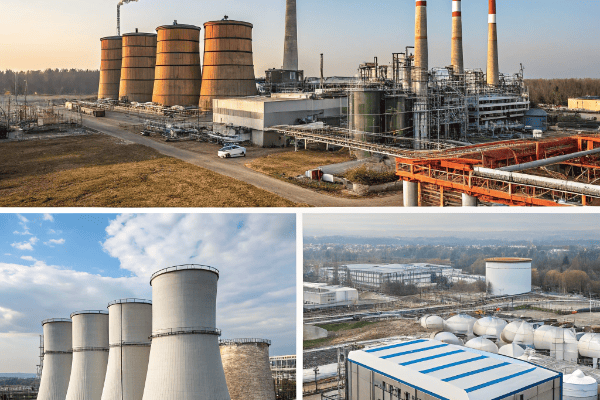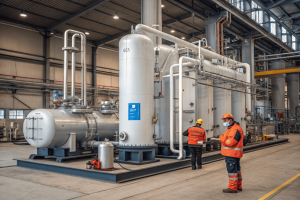What is CO₂ recovery and why do industries need it?
•
What is CO₂ recovery and why do industries need it?
Are you watching a valuable resource and potential revenue stream vent directly into the atmosphere? Many industries are, treating CO₂ as waste, which impacts both their bottom line and the environment.
CO₂ recovery is the process of capturing carbon dioxide from industrial sources, purifying it, and converting it into a usable liquid. Industries need it to reduce emissions, create a new revenue stream by selling the CO₂, and lower costs by producing their own CO₂ on-site.

I remember standing outside a large brewery years ago, watching the steam rise from their vents. I knew that steam was carrying nearly pure CO₂ from their fermentation tanks straight into the air. It struck me then that they were throwing away a product that other companies, sometimes just down the road, were paying a premium for. This realization is at the heart of what we do. We help factories see their "waste" streams not as a problem to be disposed of, but as an asset waiting to be captured.
How does CO₂ recovery work in simple terms?
The technology behind CO₂ recovery can sound complicated and intimidating. This complexity often stops businesses from even considering how it could benefit their operations, leaving money on the table.
In simple terms, CO₂ recovery is a three-step process. First, we capture the CO₂ from a gas stream. Second, we purify it to remove any contaminants. Finally, we compress and cool the pure CO₂ until it becomes a liquid, ready for storage and use.

I like to think of the process like making coffee. You start with a mix of grounds and water, separate what you want, and end up with a pure, concentrated product. CO₂ recovery is very similar. We take a mixed gas stream and use a clever system to isolate just the CO₂ molecules.
The Capture, Purify, Liquefy Cycle
Let's break down the journey of a CO₂ molecule through one of our systems.
| Step | Analogy | Technical Goal |
|---|---|---|
| 1. Capture | A chemical "sponge" soaks up CO₂ | Selectively absorb or separate CO₂ from other gases. |
| 2. Purify | "Squeezing" the sponge | Release pure CO₂ by heating the solvent; filter out water. |
| 3. Liquefy | Condensing steam into water | Compress and chill the pure CO₂ gas into a dense liquid. |
First, the gas containing CO₂ enters a column where it meets a liquid solvent, often an amine solution. This solvent acts like a chemical sponge, absorbing only the CO₂ molecules. Then, this "rich" solvent is pumped to another column and heated. This heat is like squeezing the sponge, forcing it to release almost pure CO₂ gas. Finally, this gas is compressed and refrigerated until it transforms into a liquid, which is how it’s stored and transported. It’s an elegant cycle that turns a dilute gas into a high-purity industrial product.
What types of gases can be sources of recoverable CO₂?
You might think your factory doesn't produce the "right kind" of CO₂ for recovery. By overlooking your own process emissions, you could be missing a significant opportunity for cost savings and revenue.
Almost any gas stream with a sufficient concentration of CO₂ can be a source. Common examples include off-gas from fermentation in breweries and ethanol plants, flue gas from boilers and power stations, and byproduct streams from chemical or hydrogen production.

One of the first questions a potential client asks me is, "Can you capture CO₂ from my plant?" The answer almost always depends on two things: the concentration of CO₂ in their gas stream and the type of impurities present. A stream with a high concentration of CO₂ is easier and cheaper to process than one where the CO₂ is very dilute. For example, the CO₂ coming from a brewery fermenter is over 99% pure already, making it a perfect source. Flue gas from a natural gas boiler might only be 8-10% CO₂, which presents more of an engineering challenge but is still very feasible with the right technology.
Common Sources and Their Potential
The economic viability often comes down to the quality of the source gas.
| Industry Source | Typical CO₂ Concentration | Key Consideration |
|---|---|---|
| Breweries & Ethanol Plants | >99% | Very pure, easiest and cheapest to recover. |
| Ammonia & Hydrogen Plants | 15% - 40% | High-volume, reliable source. |
| Natural Gas Boiler Flue Gas | 8% - 12% | Lower concentration, requires larger equipment. |
| Cement and Steel Production | 15% - 30% | Very large volumes, impurities must be managed. |
No matter the source, our job is to design a system that can effectively handle the specific concentration and impurity profile to deliver a final product that meets the required purity standards.
Why is CO₂ recovery becoming essential for modern factories?
Just a few years ago, venting CO₂ was standard operating procedure. Now, that same practice leads to rising carbon taxes, negative public perception, and missed revenue opportunities. The rules have changed.
CO₂ recovery is now essential for three main reasons: It reduces a factory's carbon footprint to meet regulations, it creates a valuable, sellable product from a waste stream, and it provides a reliable, on-site supply for companies that need CO₂ for their own processes.

I've seen a major shift in the industry's mindset. What was once seen as an environmental cost is now viewed as a business opportunity. The conversation has moved from "How much will it cost to comply?" to "How can we create value from this?" This shift is driven by a powerful combination of economic, regulatory, and supply chain pressures. Companies are realizing they can get ahead of carbon taxes, improve their brand image, and insulate themselves from a volatile CO₂ market all with one investment.
The Business Case for Recovery
The reasons to implement CO₂ recovery are no longer just environmental; they are fundamentally about building a more resilient and profitable business.
- Economic: Turning a waste product into a source of revenue changes the entire financial picture. For companies that use CO₂, like beverage bottlers or food processors, producing it on-site protects them from price spikes and supply chain disruptions.
- Environmental & Regulatory: With increasing global pressure and carbon pricing, reducing emissions is no longer optional. A recovery system is a proactive way to meet and exceed regulatory requirements.
- Operational Independence: Creating your own CO₂ supply chain means you are no longer dependent on outside suppliers. This can be a huge competitive advantage, especially when transportation costs rise or supply is tight.
Conclusion
CO₂ recovery transforms an industrial waste stream into a valuable asset. It's a proven technology that helps factories reduce emissions, create new revenue, and achieve greater operational independence in a changing world.
You may also be interested in:

Why is CO₂ recovery technology gaining popularity worldwide?
Why is CO₂ recovery technology gaining popularity worldwide? You see headlines about carbon capture everywhere. But you wonder if it's
Read more
How is a CO₂ recovery system designed to fit different industries?
How is a CO₂ recovery system designed to fit different industries? You're under pressure to implement a CO₂ recovery solution.
Read more
How energy-efficient are today’s CO₂ recovery technologies?
How energy-efficient are today’s CO₂ recovery technologies? You want to recover CO₂, but you fear that high electricity bills will
Read more